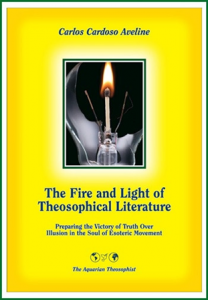
Twenty-One Occult Stories By Two
Founders of the Modern Esoteric Movement
H. P. Blavatsky and W. Q. Judge

W.Q. Judge, H. P. Blavatsky and the front cover of the 1984 edition
A 2012 Note to the Present Online Edition
Being universal wisdom, Theosophy cannot be limited to any outward form of study, perception or transmission.
It must speak to the multiple areas of human brain. It has to enlighten every nook and corner of one’s soul.
The magazine founded by H.P. Blavatsky in 1879 – “The Theosophist” – was “devoted to Oriental Philosophy, Art, Literature and Occultism”. Theosophical books and magazines typically include stories and poems.
In her writings, H.P.B. often quotes poets. She extensively discusses Russian novelists like Dostoyevsky, Tolstoy and Turgenev, and sometimes she translated texts by them. She defined French writer Balzac as “an unconscious Occultist”, and among her articles on the relation between theosophy and fiction literature one can find “The Tidal Wave”, where she comments:
“Dickens and Thackeray both born a century too late – or a century too early – came between two tidal waves of human spiritual thought, and though they have done yeoman service individually and induced certain partial reforms, yet they failed to touch Society and the masses at large. What the European world now needs is a dozen writers such as Dostoyevsky, the Russian author, whose works, though terra incognita for most, are still well known on the Continent, as also in England and America among the cultured classes.”
Many of the following stories by H. P. Blavatsky and W. Q. Judge study, describe and dismantle subconscious mechanisms of ignorance and fear in human psyche. Readers who are more inclined to look for optimism than depression have nothing to lose in carefully reading and reflecting about them, even when the narratives show the dark side of human life, for they help one get rid of the causes of emotional suffering.
One of such stories, “The Ensouled Violin”[1], has an earlier and shorter version written by a Master of the Wisdom. This was published in “The Theosophist”, January 1880, pp. 95-97, being signed by “Hillarion Smerdis, F.T.S.” , and dated “Cyprus, October 1st, 1879”. [2]
Boris de Zirkoff highlighted the fact that on letter 20 of the “Letters From the Masters of the Wisdom” (TPH), First Series, a Mahatma writes, while referring to Ms. Laura Holloway:
“…She will have in good time the help of the adept who writes stories with H.P.B.”
There can be no doubt that this was a mention to Master H.
We must thank the Theosophy Company (India) for the authorization to publish the present book in our associated websites.
Every story in this collection provides the reader with a valuable lesson in theosophy. The book includes an Appendix on Oriental Psychology (p. 234) and a Glossary starting at page 239.
The Editors.
NOTES:
[1] This particular story is full of symbolism, and its lessons can be applied to various situations according to the law of analogy. Another story of great interest to long-standing students of H.P.B. is the Cagliostrian tale “An Unsolved Mystery”. Good research done by Boris de Zirkoff on “An Unsolved Mystery” can be seen at the “Collected Writings”, H.P. Blavatsky, TPH, vol. V, pp. 159-162. Regarding Cagliostro, the “unsolved” inconsistencies present in that story should be seen as “blinds”.
[2] The same central idea of “The Ensouled Violin” inspires the 1998 Warner Brothers motion picture “The Red Violin”, 130 m., directed by François Girard. The film is available in DVD.
000
On the role of the esoteric movement in the ethical awakening of mankind during the 21st century, see the book “The Fire and Light of Theosophical Literature”, by Carlos Cardoso Aveline.

Published in 2013 by The Aquarian Theosophist, the volume has 255 pages and can be obtained through Amazon Books.
000